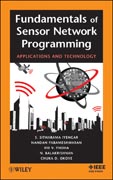
Fundamentals of sensor network programming: applications and technology
Iyengar, S. Sitharama
Parameshwaran, Nandan
Phoha, Vir V.
INDICE: PREFACE. FOREWORD. ACKNOWLEDGMENTS. ABOUT THE AUTHORS. NOTATIONS AND ABBREVIATIONS. I OVERVIEW. 1 Introduction. 1.1 Some Foundational Information. 1.2 Next-Generation Sensor Networked Tiny Devices. 1.3 Sensor Network Software. 1.4 Performance-Driven Network Software Programming. 1.5 Unique Characteristics of Programming Environments for Sensor Networks. 1.6 Goals of the Book. 1.7 Why TinyOS and NesC. 1.8 Organization of the Book. 1.9 Future Demands on Sensor-Based Software. Problems. References. 2 Wireless Sensor Networks. 2.1 Sensor Network Applications. 2.2 Characteristics of Sensor Networks. 2.3 Nature of Data in Sensor Networks. 3 Sensor Technology. 3.1 Sensor Level. 3.2 Server Level. 3.3 Client Level. 3.4 Programming Tools. II BACKGROUND. 4 Data Structures for Sensor Computing. 4.1 Introduction to Sensor Computing. 4.2 Communication Capabilities. 4.3 General Structure of Programming. 4.4 Details on EmbeddedData Structures. 4.5 Linked List. 4.6 Importance of Graph Concepts in Sensor Programming. 4.7 Graph and Trees. 4.8 Trees. 4.9 Graph Traversal. 4.10 Connectivity. 4.11 Planar Graphs. 4.12 Coloring and Independence. 4.13 Clique Covering. 4.14 Intersection Graph. 4.15 Defining Data Structure of Spanning Tree Protocols. Problems. References. 5 Tiny Operating System (TinyOS). 5.1 Components of TinyOS. 5.2 An Introduction to NesC. 5.3 Event-Driven Programming. 6 Programming in NesC. 6.1 NesC Programming. 6.2 A Simple Program. III SENSOR NETWORK IMPLEMENTATION. 7 Sensor Programming. 7.1 Programming Challenges in Wireless Sensor Networks. 7.2 Sensing the World. 7.3 Applications Using the Interface SplitControl. Problems. References. 8 Algorithms forWireless Sensor Networks. 8.1 Structural Characteristics of Sensor Nodes. 8.2 Distinctive Properties of Wireless Sensor Networks. 8.3 Sensor Network Stack. 8.4 Synchronization in Wireless Sensor Networks. 8.5 Collision Avoidance: Token-Based Approach. 8.6 Carrier Sensing Versus Decoding. 9 Techniques for Protocol Programming. 9.1 The Mediation Device Protocol. 9.2 Contention-Based Protocols. 9.3 Programming with Link-Layer Protocols. 9.4 Automatic Repeat Request (ARQ) Protocol. 9.5 Transmitter Role. 9.6 Alternating-Bit-Based ARQ Protocols. 9.7 Selective Repeat/Selective Reject. 9.8 Naming and Addressing. 9.9 Distributed Assignment of Networkwide Addresses. 9.10 Improved Algorithms. 9.11 Content-Based Addressing. 9.12 Flooding. 9.13 Rumor Routing. 9.14 Tracking. 9.15 Querying in Rumor Routing. IV REAL-WORLD SCENARIOS. 10 Sensor Deployment Abstraction. 10.1 Sensor Network Abstraction. 10.2 Data Aggregation. 10.3 Collaboration Group Abstractions. 10.4 Programming Beyond Individual Nodes. Problems. References. 11 Standards for Building Wireless Sensor Network Applications. 11.1 802.XX Industry Frequency andData Rates. 11.2
- ISBN: 978-0-470-87614-5
- Editorial: John Wiley & Sons
- Encuadernacion: Cartoné
- Páginas: 344
- Fecha Publicación: 03/12/2010
- Nº Volúmenes: 1
- Idioma: Inglés
